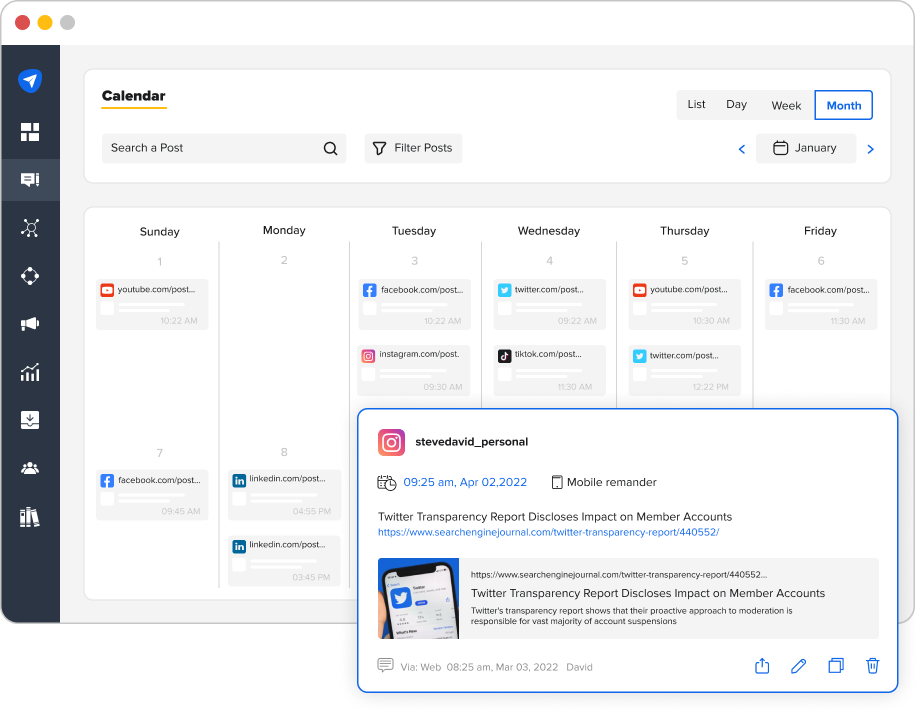Social media isn’t just about connecting with friends and family and staying updated about current events. Businesses use this gold mine to reach a wider audience, build stronger relationships, and ultimately achieve their business goals.
But without a proper plan of action, the desire to reach the masses remains a dream.
This is where social media management comes into play!
It is the practice of creating, scheduling, analyzing, and engaging with content posted on social media platforms to achieve specific goals for a company, brand, or individual.
This not only helps you build brand awareness but also generates leads and sales, increases loyalty, and amplifies your social media marketing efforts.
In this guide, we will explain social media management, its perks, and how to do it properly to leave a lasting impression on your consumers.
What is Social Media Management?
Always good to start with the basics!
Social media management (SMM) is the process of planning, creating, scheduling, analyzing, and even engaging with content on social media platforms like Facebook, Instagram, Twitter, TikTok, YouTube, and more.
To effectively manage your social media, you require a deep understanding of different social media platforms, your target audience, business priorities, and what type of content resonates with them.
Social media management lets you monitor the performance and effectiveness of your campaigns, engage with your followers by proactively responding to comments and messages, and build a strong brand identity.
By tracking KPIs such as engagement rate, follower growth, click-through rate, and conversion rate, you can gain insights that help you refine your strategy.
Overall, it is essentially the process of using social media to your advantage, not by randomly posting but with a strategic approach to achieve your business goals.
Benefits of Social Media Management?
Social media is transforming at an unprecedented rate, leaving brands with a large void to fill. Nowadays, simply having a presence on social media platforms isn’t enough. To truly make the most of this opportunity, you need a strategic approach—that’s where social media management steps in.
Here’s how this can significantly benefit you:
Increased Brand Awareness and Visibility
Brand awareness refers to the level of familiarity your target audience has with you and how well they recognize your brand and products through a name, logo, or distinctive qualities.
SMM is a gem that helps you improve your brand awareness and garner visibility. With this, you reach your target audience and get your brand noticed by using high-quality content that creates an image in the minds of your audience.
Enhanced Brand Loyalty and Relationships
Social media isn’t a one-way road. You give value to the people, and in return, you build genuine relationships that last a lifetime. SMM empowers you to connect with your audience more deeply by responding to comments and messages promptly.
This shows how much you care about your consumers, builds trust, fosters relationships and a sense of belonging.
Lead Generation and Sales Growth
Brands use social media as a marketing channel, not out of goodwill, and what good is a marketing channel if it is not helping generate leads?
You can attract potential customers to your website or landing pages by sharing valuable content and special offers. You can nurture leads by effectively using SMM, ultimately converting them into paying customers.
Improved Customer Service
Your customers won’t stay with you forever if you don’t treat them well or respond to their concerns. SMM makes it easier and more convenient for brands to resolve customer complaints quickly. Social listening lets you identify and address concerns before they escalate and backfire on you.
How to Do Social Media Management?
Have you heard there’s always a better way to do things?
Especially when you’re representing a business or your own professional profiles, you need to effectively manage your social media and minimize any wasted opportunities to cut through the noise.
Thats is why we have discussed these strategies to help you guide to master social media management:
Step 1: Develop a Winning Social Media Strategy
First thing first, you must have a plan of action for social media.
Establishing an objective from the outset clears up any potential ambiguities. Collaborative efforts on social media lose their purpose without a well-defined aim. Additionally, it unifies individuals to strive for a shared objective.
Instead of setting ambiguous objectives, consider these suggestions to craft effective social media partnership goals to enhance your team’s productivity.
- Set realistic and achievable goals
- It should support the vision or values of your brand’s social presence
- It should be measurable
- Be as specific as you can
Take a look at this example:
Here’s how you can get started with your social media strategy:
- Define your goals: What do you want to achieve with social media? Is it to improve awareness, lead generation, boost sales, or build a community? A robust strategy includes SMART goals (Specific, measurable, achievable, relevant, and time-bound) that guide your entire SMM strategy. For instance, do you aim to increase your follower count by X% within six months or boost your engagement rate by Y% per quarter?
- Audience research: Who are you trying to reach? Understanding your target demographics, interests, and preferred networks is crucial to crafting a tailored content strategy. Every social network offers insights into business and creator profiles. You can use native analytics, Facebook Insights, or Google Analytics or run surveys to collect data about the target audience.
- Competitive analysis: If you’re struggling to reach a conclusion, it’s never a bad idea to analyze your competitors, understand what they’re doing, and use these learnings as a starting point. Utilize tools like BuzzSumo or SEMRush to see what content is working for your competitors and how they engage with their followers. Apply these insights to differentiate your approach.
Step 2: Create Social Media Content
Now that you have created your strategy, the next step is to get started with the content.
Creating high-quality content that informs, engages, and entertains your audience is essential to capturing your audience and encouraging interaction, ultimately strengthening your brand presence. Here’s how you can create compelling content that resonates with your audience:
Develop a content calendar: A content calendar can help you organize your posting schedule and maintain consistency, which is the key to keeping your audience engaged.
- Mix-up Formats: Experiment with various content types, such as text, images, videos, and podcasts, to see what resonates with them. Show your brand’s unique perspective. People connect with genuine voices, so don’t be afraid. You must also keep your brand voice consistent across platforms and content types. Whether it is professional, casual, creative, or friendly, it needs to be consistent across posts.
- User-Generated Content: Encourage followers to share their own content or stories about your brand. This not only gives you additional content to share but also helps build community and trust among your audience.
- Storytelling: A story is like the backbone of a picture; if it falls short, the movie becomes a flop. The same goes for marketing content. While creating content, use storytelling to make it more impactful and memorable than standard posts. Share stories about your brand, customer testimonials, or BTS.
- Visual Appeal: Ensure your content is visually appealing. Use high-quality, royalty-free images and maintain a consistent aesthetic style that aligns with your brand. Tools like Canva, Adobe Spark, or Microsoft designer can help create professional-looking graphics without needing extensive design skills.
Step 3: Collaborate With Team
The lack of alignment within the team impacts the outcome of a task or project. This principle holds true for your social media management as well. Whether you’re a small business or a large agency, managing social media is a team effort.
From strategizing to analyzing outcomes, every step gains momentum with cohesive collaboration. But how do you ensure that every team member is in sync and the collaboration is seamless?
Here are some tips that you can follow:
a. Prepare a collaboration strategy
Fostering a culture of responsibility is key to successful social media partnerships. It is wise to allocate roles to individual team members from the beginning. Establishing and consistently enforcing guidelines ensures everyone understands their specific duties.
Never assume your team knows their roles; relying on memory isn’t enough. Instead, draft a precise strategy that delineates each person’s responsibilities.
To reduce interdependencies, allocate tasks to team members based on their strengths and expertise. By limiting these dependencies, you boost each member’s efficiency, which naturally leads to heightened team productivity.
The major components of your collaboration plan will broadly include:
- Assigning roles and delegating task
- Preparing a crystal clear timeline for each task
- Setting clear expectations
- Documenting the above three points
b. Assign roles
The section above leads us to one essential observation:
You can’t establish a clear process for everyone unless you have precise roles for all your team members.
Usually, a marketing team that deals with social media has the following people:
- Social Media Manager: The social media manager ensures everyone collaborates successfully with their team. They also do general research and assign tasks.
- Content Creator: Content creators receive briefs and use their creative cogs to research and deliver the required content.
- Community Manager: Community managers manage relationships with the community. They’re involved in communications and PR, including events and some customer service. They’re also the ears of your marketing team, using their top-notch interpersonal skills for social listening.
- Analysis: Analysts will monitor the results of your marketing team’s activities, ensuring that their endeavors are effective. They will provide progress reports with practical insights to reorganize a faulty campaign and plan more successful ones in the future.
c. Leverage a social media calendar
Working in a team can increase the chances of overlaps and missed opportunities. A shared calendar is the glue that binds a team, ensuring everyone’s on the same page, working in harmony towards a unified goal.
You can:
- Assign responsibilities: Clearly define who is responsible for what. Whether content creation, graphic design, or analytics, assign tasks and deadlines to avoid confusion.
- Plan for key dates: Be it holidays, product launches, or industry-specific events, planning ensures you’re not missing out on key engagement opportunities.
- Review and adjust: A dynamic calendar allows for regular reviews. Analyze the performance of past posts and adjust future strategies accordingly.
- Centralized feedback: Use the calendar as a feedback platform. Team members can leave comments or suggestions on scheduled posts, ensuring content is refined before going live.

If you’re new to using a social media calendar, start with a basic spreadsheet. As you become more accustomed, consider investing in specialized software that offers more features. Also, hold weekly or bi-weekly meetings to review the calendar. Discuss upcoming posts, assign tasks, and gather feedback.
Most importantly, ensure every team member understands the importance of the calendar and how to use it. Regular training sessions can be beneficial.
Step 4: Run Paid Ads
Running social media ads can significantly influence your marketing efforts and business outcomes. If you’re thinking about driving quick results, advertisements can be a good way to go. Start by
Segmenting your audience: To tailor your ads, create audience segments based on demographics, interests, and behaviors. Platforms like Facebook and Instagram offer detailed targeting options.
Allocate budget: Use a tiered approach for budgeting. Start small with ads to test and scale up spending where you are getting good ROI.
A/B testing: Regularly perform A/B tests on your ads, comparing images, headlines, and CTAs to determine which campaigns are performing the best and optimizing accordingly.
Note: Use tools like Google Transparency Center to identify what ads your competitors are running and implement those changes in your ads.
Step 5: Analytics and Reporting
Tracking the right metrics is essential for the success of your social media campaigns and making informed decisions to increase the impact. Here’s a breakdown for you:
Set KPIs: Start by establishing KPIs such as follower growth, engagement rate, CTR, conversion rate, and more. You can use tools like SocialPilot and native analytics to help get access to these data.
Monthly reports: Create detailed monthly reports to analyze the effectiveness of your organic content and ads.
Use these insights to identify what type of content gets the most engagement and the best times to post, and implement these to fine-tune your social media strategy.
Step 6: Use a Social Media Management Tool
There is always a smart way to manage your social media—the one that allows you to be creative with your content, save time, collaborate with your team, and analyze your social media performance.
The right tool can remove all your social media woes and streamline your entire workflow. SocialPilot is a tool that helps you with scheduling your content, planning campaigns, effortlessly collaborating with teams, and measuring performance.
You can respond to your customer messages from inside the tool. Also, create and schedule reports to regularly track how your content activities are doing.
Step 7: Crisis Management
At last, you should always have a backup plan incase somethings go south.
Draft a crisis communication plan that includes steps for dealing with various types of crises, from product recalls to PR scandals. Identify which spokesperson will speak on behalf of the company and what channels will be used.
Also, track social mentions to see what’s being said about your brand in real-time. This can help you react quickly to mitigate any potential issues.
The Role of a Social Media Manager
The role of a Social Media Manager is critical in shaping a brand’s image and presence across various social media platforms.
The responsibilities involve strategic planning, execution, and monitoring of all activities with the aim of increasing brand awareness, promoting products or services, and engaging with customers and potential clients.
Here’s a detailed breakdown of the responsibilities and skills involved in the role of a Social Media Manager:
- Social Media Calendar: A calendar is a must for a social media manager to plan all activities and execute them in a timely manner. The roles require you to organize and schedule all tasks using a calendar.
- Content strategy: A calendar is useless without a content strategy. Develop a strategy that outlines what types of content you will post on which platforms and when. This includes spotting goals, target audiences, and KPIs.
- Content creation: Creating content is the key pillar of the entire structure. Produce high-quality content that aligns with the brand’s voice and content strategy. This can include creating Instagram Reels, YT Shorts, and TikTok videos, writing blog posts, shooting videos, and editing content.
- Campaign reporting: Once you have successfully mastered the art of consistency, you need to pull out your social media reports to track which campaigns drove your growth.
- Community management: Engage with your fan army by responding to their comments, DMs, and reviews. Track brand mentions and feedback and build a positive community atmosphere.
- Business development: Businesses use social media to help grow their businesses and create product/service awareness among their target users. As a social media manager, you need to identify and seize opportunities for business growth, such as partnerships, collaborations, and more.
- Social media proposals: Sending our proposals to clients or internal stakeholders, outlining planned strategies, and budget estimations are part of the role.
That’s it for this guide. Now, it’s your turn to test these methods out and share your outcomes with us on your favorite social media networks by tagging us @socialpilot.
Happy growing!




